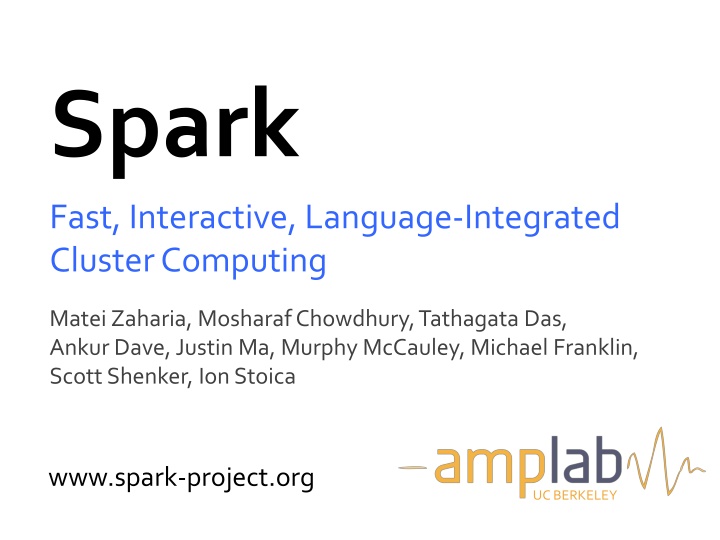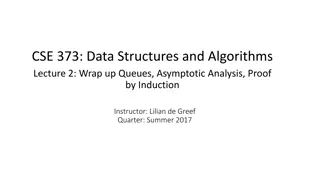
Spark: Fast, Interactive Cluster Computing with RDDs
"Learn about Spark, an innovative cluster computing framework that extends the MapReduce model, supports iterative algorithms and interactive data mining, and efficiently manages working sets with Resilient Distributed Datasets (RDDs). Explore its goals, motivation, and solutions for enhanced performance and programmability."
Download Presentation

Please find below an Image/Link to download the presentation.
The content on the website is provided AS IS for your information and personal use only. It may not be sold, licensed, or shared on other websites without obtaining consent from the author. If you encounter any issues during the download, it is possible that the publisher has removed the file from their server.
You are allowed to download the files provided on this website for personal or commercial use, subject to the condition that they are used lawfully. All files are the property of their respective owners.
The content on the website is provided AS IS for your information and personal use only. It may not be sold, licensed, or shared on other websites without obtaining consent from the author.
E N D
Presentation Transcript
Spark Fast, Interactive, Language-Integrated Cluster Computing Matei Zaharia, Mosharaf Chowdhury, Tathagata Das, Ankur Dave, Justin Ma, Murphy McCauley, Michael Franklin, Scott Shenker, Ion Stoica www.spark-project.org UC BERKELEY
Project Goals Extend the MapReduce model to better support two common classes of analytics apps: Iterative algorithms (machine learning, graphs) Interactive data mining Enhance programmability: Integrate into Scala programming language Allow interactive use from Scala interpreter
Project Goals Extend the MapReduce model to better support two common classes of analytics apps: Iterative algorithms (machine learning, graphs) Interactive data mining Enhance programmability: Integrate into Scala programming language Allow interactive use from Scala interpreter Explain why the original MapReduce model does not efficiently support these use cases?
Motivation Most current cluster programming models are based on acyclic data flow from stable storage to stable storage Map Reduce Input Output Map Reduce Map
Motivation Most current cluster programming models are based on acyclic data flow from stable storage to stable storage Map Reduce Benefits of data flow: runtime can decide Input where to run tasks and can automatically Output Map recover from failures Reduce Map
Motivation Acyclic data flow is inefficient for applications that repeatedly reuse a working set of data: Iterative algorithms (machine learning, graphs) Interactive data mining tools (R, Excel, Python) With current frameworks, apps reload data from stable storage on each query
Solution: Resilient Distributed Datasets (RDDs) Allow apps to keep working sets in memory for efficient reuse Retain the attractive properties of MapReduce Fault tolerance, data locality, scalability Support a wide range of applications
Programming Model Resilient distributed datasets (RDDs) Immutable, partitioned collections of objects Created through parallel transformations (map, filter, groupBy, join, ) on data in stable storage Can be cached for efficient reuse Actions on RDDs Count, reduce, collect, save,
Example: Log Mining Load error messages from a log into memory, then interactively search for various patterns Cache 1 Base RDD Transformed RDD lines = spark.textFile( hdfs://... ) Worker results errors = lines.filter(_.startsWith( ERROR )) tasks messages = errors.map(_.split( \t )(2)) Block 1 Driver cachedMsgs = messages.cache() Action cachedMsgs.filter(_.contains( foo )).count Cache 2 cachedMsgs.filter(_.contains( bar )).count Worker . . . Cache 3 Block 2 Worker Result: scaled to 1 TB data in 5-7 sec Result: full-text search of Wikipedia in <1 sec (vs 20 sec for on-disk data) (vs 170 sec for on-disk data) Block 3
RDD Fault Tolerance RDDs maintain lineage information that can be used to reconstruct lost partitions Ex: messages = textFile(...).filter(_.startsWith( ERROR )) .map(_.split( \t )(2)) HDFS File Filtered RDD Mapped RDD filter map (func = _.contains(...)) (func = _.split(...))
Example: Logistic Regression Goal: find best line separating two sets of points random initial line target
Example: Logistic Regression val data = spark.textFile(...).map(readPoint).cache() var w = Vector.random(D) for (i <- 1 to ITERATIONS) { val gradient = data.map(p => (1 / (1 + exp(-p.y*(w dot p.x))) - 1) * p.y * p.x ).reduce(_ + _) w -= gradient } println("Final w: " + w)
Logistic Regression Performance 4500 4000 127 s / iteration 3500 Running Time (s) 3000 2500 Hadoop 2000 Spark 1500 1000 500 first iteration 174 s further iterations 6 s 0 1 5 10 20 30 Number of Iterations
Spark Operations flatMap union join cogroup cross mapValues map filter sample groupByKey reduceByKey sortByKey Transformations (define a new RDD) collect reduce count save lookupKey Actions (return a result to driver program)
YARN HDFS










